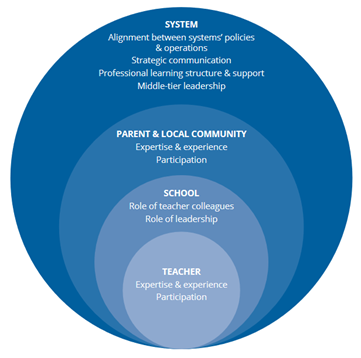
What is needed to improve teacher professional development initiatives?
Research 4 Jul 2024 6 minute readA multi-year, multi-country study in the Indo-Pacific region has identified strategies that can help shape future teacher professional development initiatives.
Teachers are one of the most important in-school factors influencing student learning outcomes. Recognising this, the Australian Government’s Department of Foreign Affairs and Trade (DFAT), initiated the Teacher Development Multi-Year Studies to understand the impact of its investments in teacher professional development.
Over 5 years, ACER conducted research in Timor-Leste, Vanuatu, and Lao People’s Democratic Republic (PDR), to understand how DFAT’s education investments have impacted teaching quality and student learning outcomes. It also sought to understand the conditions for success for teacher professional development investments, and how lessons learned can inform future programming.
The study series highlighted the importance of approaching teacher professional development with systems thinking. This requires consideration of how program design, systems and contextual factors can work together to shape the success of teacher professional development initiatives. Drawing from international literature and field observations, the research describes ‘best practice’ professional development program design as encompassing features such as quality instruction, sustained and regular engagement, pedagogical content knowledge, aligned teaching and learning resources, and closely linked to classroom practice. These baseline features are the foundations for developing appropriate professional learning that considers systems and contextual factors.
Findings from the study series emphasise the importance of addressing factors at all levels within the education system – teacher, school, parent and community, and system. By doing this, education systems can create an environment conducive to the success and sustainability of teacher development initiatives.
Different levels within an education system

The Multi-Country Report presents strategies for future thinking in teacher professional development initiatives that provide an opportunity for more effective teacher learning and professional practice. This involves moving away from the accepted or current ways of working towards change that can impact system coherence, motivation and develop a mindset that considers the local and specific experiences of teachers, leaders and their schools. While there are many common characteristics among teacher professional development initiatives, a key consideration is how they ‘best fit’ within a particular context.
To be effective, teacher professional development needs to be bolstered by a coherent system of professional learning structures and support. This includes aligning policies and operations, ensuring all education stakeholders – including communities and parents – understand changes and the role they play, and putting the right structures in place to effectively implement these changes. By engaging stakeholders through clear and comprehensive communications channels, reform initiatives can gain traction and foster a culture of inclusivity and feedback.
Professional learning structures need long-term resourcing and budgeting to shift from one-off training sessions towards sustainable systems that provide continuous professional learning opportunities. Middle-tier leadership plays a pivotal role in driving effective teacher development. Shifting the focus from supervision to mentorship and coaching support, instructional leaders can cultivate a culture of collaboration and skill development among educators. By incentivising leaders to prioritise instructional support and evidence-based interventions, schools use data to tailor professional learning experiences to meet the diverse needs of teachers and students.
The school context plays a key role in how teachers implement what they learn through professional development in their classrooms. Teacher peers and school leadership can create a supportive and reflective environment as teachers work to implement new practices. Investing in the leadership skills of school leaders and focusing on teaching and learning improvement is critical.
Teacher professional development is more likely to be effective when it meets the needs of teachers and the contexts in which they work. The approach and design should consider teacher experience, expertise, and pre-existing ideas, values and attitudes.
By investing in strategies that can help shape future teacher professional development initiatives, education systems can create an environment where every student has access to quality learning experiences, facilitated by empowered and supported teachers.
Further reading
Read the Multi-Country Report Highlights.
Read the full Multi-Country Report.
Read more reports from the Education Analytics Service Teacher Professional Development Multi-Country Studies.